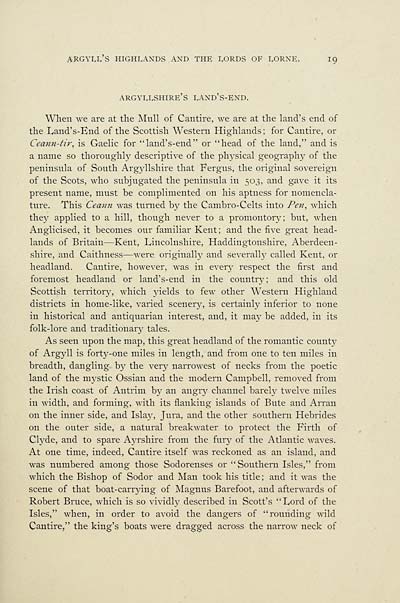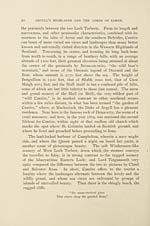Download files
Complete book:
Individual page:
Thumbnail gallery: Grid view | List view

ARGYLL'S HIGHLANDS AND THE LORDS OF LORNE. 19
ARGYLLSHIRE'S LAND'S-END.
When we are at the Mull of Cantire, we are at the laud's end of
the Land's-End of the Scottish Western Highlands ; for Cantire, or
Ceann-tir, is Gaelic for "laud's-end" or "head of the land," and is
a name so thoroughly descriptive of the physical geography of the
peninsula of South Argyllshire that Fergus, the original sovereign
of the Scots, who subjugated the peninsula in 503, and gave it its
present name, must be complimented 011 his aptness for nomencla-
ture. This Ceann was turned by the Cambro-Celts into Pen, which
they applied to a hill, though never to a promontory; but, when
Anglicised, it becomes our familiar Kent; and the five great head-
lands of Britain — Kent, Lincolnshire, Haddingtonshire, Aberdeen-
shire, and Caithness — were originally and severally called Kent, or
headland. Cantire, however, was in every respect the first and
foremost headland or land's-end in the country; and this old
Scottish territory, which yields to few other Western Highland
districts in home-like, varied scenery, is certainly inferior to none
in historical and antiquarian interest, and, it may be added, in its
folk-lore and traditionary tales.
As seen upon the map, this great headland of the romantic county
of Argyll is forty-one miles in length, and from one to ten miles in
breadth, dangling by the very narrowest of necks from the poetic
land of the m}-stic Ossian and the modem Campbell, removed from
the Irish coast of Antrim by an angry channel barely twelve miles
in width, and forming, with its flanking islands of Bute and Arran
on the inner side, and Islay, Jura, and the other southern Hebrides
on the outer side, a natural breakwater to protect the Firth of
Clyde, and to spare Ayrshire from the fury of the Atlantic waves.
At one time, indeed, Cantire itself was reckoned as an island, and
was numbered among those Sodorenses or "Southern Isles," from
which the Bishop of Sodor and Man took his title; and it was the
scene of that boat-carrying of Magnus Barefoot, and afterwards of
Robert Bruce, which is so vividly described in Scott's "Lord of the
Isles," when, in order to avoid the dangers of "rounding wild
Cantire," the king's boats were dragged across the narrow neck of
ARGYLLSHIRE'S LAND'S-END.
When we are at the Mull of Cantire, we are at the laud's end of
the Land's-End of the Scottish Western Highlands ; for Cantire, or
Ceann-tir, is Gaelic for "laud's-end" or "head of the land," and is
a name so thoroughly descriptive of the physical geography of the
peninsula of South Argyllshire that Fergus, the original sovereign
of the Scots, who subjugated the peninsula in 503, and gave it its
present name, must be complimented 011 his aptness for nomencla-
ture. This Ceann was turned by the Cambro-Celts into Pen, which
they applied to a hill, though never to a promontory; but, when
Anglicised, it becomes our familiar Kent; and the five great head-
lands of Britain — Kent, Lincolnshire, Haddingtonshire, Aberdeen-
shire, and Caithness — were originally and severally called Kent, or
headland. Cantire, however, was in every respect the first and
foremost headland or land's-end in the country; and this old
Scottish territory, which yields to few other Western Highland
districts in home-like, varied scenery, is certainly inferior to none
in historical and antiquarian interest, and, it may be added, in its
folk-lore and traditionary tales.
As seen upon the map, this great headland of the romantic county
of Argyll is forty-one miles in length, and from one to ten miles in
breadth, dangling by the very narrowest of necks from the poetic
land of the m}-stic Ossian and the modem Campbell, removed from
the Irish coast of Antrim by an angry channel barely twelve miles
in width, and forming, with its flanking islands of Bute and Arran
on the inner side, and Islay, Jura, and the other southern Hebrides
on the outer side, a natural breakwater to protect the Firth of
Clyde, and to spare Ayrshire from the fury of the Atlantic waves.
At one time, indeed, Cantire itself was reckoned as an island, and
was numbered among those Sodorenses or "Southern Isles," from
which the Bishop of Sodor and Man took his title; and it was the
scene of that boat-carrying of Magnus Barefoot, and afterwards of
Robert Bruce, which is so vividly described in Scott's "Lord of the
Isles," when, in order to avoid the dangers of "rounding wild
Cantire," the king's boats were dragged across the narrow neck of
Set display mode to:
![]() Universal Viewer |
Universal Viewer | ![]() Mirador |
Large image | Transcription
Mirador |
Large image | Transcription
Images and transcriptions on this page, including medium image downloads, may be used under the Creative Commons Attribution 4.0 International Licence unless otherwise stated. ![]()
| Histories of Scottish families > Argyll's Highlands, or, MacCailein Mor and the Lords of Lorne > (39) Page 19 |
|---|
| Permanent URL | https://digital.nls.uk/95002330 |
|---|
| Description | A selection of almost 400 printed items relating to the history of Scottish families, mostly dating from the 19th and early 20th centuries. Includes memoirs, genealogies and clan histories, with a few produced by emigrant families. The earliest family history goes back to AD 916. |
|---|

